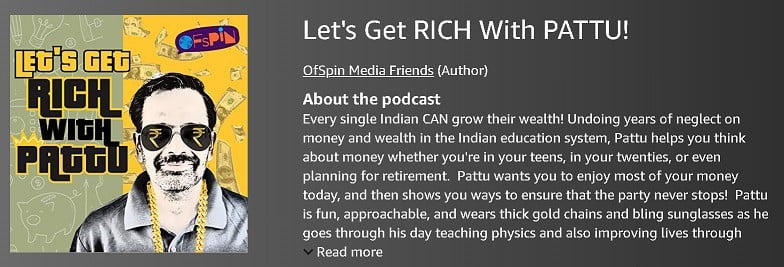In this article, we discuss the difference between risk and volatility and why one must not misinterpret the difference!
What is risk? Risk can be defined as any factor that can result in a loss of value. For example, if you buy something for Rs. 10 and after a year its market value is Rs. 25. A month later its market value has decreased to Rs. 22 is an example of risk. Risk is the possibility of value erosion with or without loss of principal.
There are many factors that can result in a change in the value of an asset and each of them is usually classified as a type of risk. Some factors result in daily price changes and some occasional price changes. Some factors are market-linked and some are not. Many of these factors work both ways. That is, they increase asset value sometimes and decrease it sometimes. So risk is a double-edged sword.
Some risks are visible daily and some appear to strike suddenly. Thus most often, risk results from a lack of anticipation. Let us understand these statements with examples.
1 Default risk or credit risk: This is the risk of the borrower not paying back the principal and/or defaulting on interest payments. The way this risk manifests on a daily basis is complex.
Join 32,000+ readers and get free money management solutions delivered to your inbox! Subscribe to get posts via email! (Link takes you to our email sign-up form)
🔥Want to create a complete financial plan? Learn goal-based investing? Exclusive access to our DIY tools? Increase your income with your skills? Use this link to enjoy massive discounts on our robo-advisory tool & courses! 🔥
- Market-linked credit risk: Suppose a bond is rated AAA on its issue. After a few months, rating agencies downgrade it to AA. Then the price of the bond will fall. If the rating is restored to AAA later, the price will increase. There has not been an actual default but a mere change in credit rating has resulted in occasional price changes.
- Non-market linked: Suppose you buy the same bond with the intention of holding it until maturity. Until there is an actual delay in interest rate payment or the possibility of non-payment of principal, changes in credit rating will not affect you.
- Another example of non-market linked credit risk: Suppose RBI suspends the banking licence of your bank. You will only get back Rs. 5 lakh and it also depends on how soon you get that money back.
- These are examples of invisible risk. Before the credit agency or regulator makes the announcement, not much is known about the health of the borrower to the typical retail investor.
2 Reinvestment risk: Suppose you buy and hold a bond or fixed deposit until maturity for 8%. When the amount matures and you wish to reinvest, the interest rates are down to 6% you are forced to earn less. This is inevitable in a developing economy.
- Market-linked reinvestment risk: A few years ago, liquid fund returns were 9% a year. Many investors in FB group Asan Ideas for Wealth looked at this and assumed they will also get the same. Interest rates dropped and newer bonds had lower coupon rates. So gradually liquid fund returns started decreasing. This is also an example of past performance risk.
3 Redemption risk: When too many people try to redeem from a bank (aka bank run) or from a mutual fund holding illiquid assets, the NAV of the fund will drop. Recall in the movie the big short, redemptions were stopped from Michael Burry’s fund. Franklin closed down six of its schemes because of this.
I mentioned above, risk results from a lack of anticipation. The Franklin episode was such an instance for me. While I anticipated credit risk in their funds, I did not anticipate redemption risk although we had one such example of redemption risk in 2008.
4 Interest rate risk: Those holding bonds will feel the pain when newer bonds of higher coupon rates are issued. This also impacts the bond market but the speculation of rate change usually plays a bigger role in impacting bond prices and debt fund NAVs unless there is an unexpected event like in July 2013 when the overnight rate increased by 2% resulting in a “bond crash”.
Similarly, there are other types of risk like currency risk, geographic risk (eg. if someone held investments in Ukraine or Russia now), inflation risk etc.
What is volatility? Volatility is one way to measure the extent of visible risk. It is a measure of price fluctuations of an asset, stock, index or mutual fund NAV. The standard deviation is used to represent volatility and gives us an idea of much prices fluctuate.
Visible risk here means frequently occurring risk. A crash in the debt fund NAV due to a bond default is not a daily occurring risk (hopefully!). It must be kept in mind that such occasional risks can adversely affect the volatility measure and care must be taken to use volatility with context.
Typically the standard deviation uses daily or weekly or monthly absolute returns. It is defined as the average deviation of each return from the average return. The higher the value, the higher the price fluctuations.
Volatility tells you how much the price fluctuates relative to some asset class like a liquid fund or overnight fund that does not fluctuate much. However, volatility does not tell you the cause of the visible risk.
That visible risk can be due to any of the above-mentioned risks: credit rating changes, speculation on interest rate movements, speculation on currency supply vs demand, inflationary pressures etc. It must be understood that price movements occur due to speculation of a good or bad event and the actual event itself or some other sudden unexpected event.
Some of you may think is not the underlying cause (risk) more important than the extent of fluctuations (volatility). Not quite. The visible risks mentioned above affect the asset price at the same time on a daily basis. So it is hard to identify individual risks. Moreover, you can only identify the risk or fluctuation after it has occurred. So it cannot provide your specific guidance about the future, only generic advice (which for most is more than enough!).
To summarise, risk is any factor that results in a change in the value of an investment. Volatility is one way to measure the extent of frequently occurring (visible) risks without identifying the source of the risk. Drawdowns, downside capture, Ulcer index are some other visible risk measures.
How risk ≠ volatility is misinterpreted (often conveniently)
So risk is not the same as volatility in the same way as obesity is not the same as a BMI (BMI is one way to measure the extent of obesity but the underlying cause of obesity requires further investigation).
This does not mean volatility is not important! Many people argue that volatility is day-to-day price fluctuations and is not important for making returns from equity over the long run. As one may expect these are either product sellers or product manufacturers.
What we fail to recognise is, when the price of an asset class fluctuates, its return also fluctuates. So when we say the volatility of an asset is high, it means its return can fluctuate wildly. See: Stock market always moves up in the long term but returns move up and down! And Do not expect returns from mutual fund SIPs! Do this instead!
Why the price fluctuates is an interesting study especially if we are going to be given a degree for it. But in the real world, we need to make some money and for this, we need to understand the extent of volatility more than the cause of the volatility!
A young reader recently wrote to me saying, “why to bother about day to price fluctuations! If we buy good companies we are likely to make money over the long term”. Spot the risk in this statement!
So the point is, the extent of volatility in our investments tell us how much actual returns can fluctuate above and below our expected returns and is extremely important! So too are the invisible or infrequent risks that do not show in the volatility!
I hate to be the one to break it to you but there is zero evidence that long term systematic investing in equity will give you a good return over the long term or we will get a return close to what we expect.
The only evidence available is there is a reasonable chance that equity will beat inflation over the long term. See: Why should I invest in equity mutual funds when there is no guarantee of returns?
These two are not the same! After 15Y, 8% = inflation-beating return (it is even today!!) Sitting and hoping for a 12% return and getting 8% from equity after 15Y is = failure. See: Equity may beat inflation but that doesn’t mean you will!
Expecting less and trying to invest more than necessary is essential. In addition, every year the asset allocation and return expectation should be evaluated with a specific goal in mind. We need to appreciate both volatility and risks to avoid slip-ups in our investment journey.
To get started the right way, you can consider watching this seminar: Basics of portfolio construction: A guide for beginners

Use our Robo-advisory Tool to create a complete financial plan! ⇐More than 3,000 investors and advisors use this! Use the discount code: robo25 for a 20% discount. Plan your retirement (early, normal, before, and after), as well as non-recurring financial goals (such as child education) and recurring financial goals (like holidays and appliance purchases). The tool would help anyone aged 18 to 80 plan for their retirement, as well as six other non-recurring financial goals and four recurring financial goals, with a detailed cash flow summary.
🔥You can also avail massive discounts on our courses and the freefincal investor circle! 🔥& join our community of 8000+ users!
Track your mutual funds and stock investments with this Google Sheet!
We also publish monthly equity mutual funds, debt and hybrid mutual funds, index funds, and ETF screeners, as well as momentum and low-volatility stock screeners.
You can follow our articles on Google News

We have over 1,000 videos on YouTube!

Join our WhatsApp Channel



- Do you have a comment about the above article? Reach out to us on Twitter: @freefincal or @pattufreefincal
- Have a question? Subscribe to our newsletter using the form below.
- Hit 'reply' to any email from us! We do not offer personalised investment advice. We can write a detailed article without mentioning your name if you have a generic question.
Join 32,000+ readers and get free money management solutions delivered to your inbox! Subscribe to get posts via email! (Link takes you to our email sign-up form)
About The Author
 Dr M. Pattabiraman (PhD) is the founder, managing editor and primary author of freefincal. He is an associate professor at the Indian Institute of Technology, Madras. He has over 13 years of experience publishing news analysis, research and financial product development. Connect with him via Twitter(X), LinkedIn, or YouTube. Pattabiraman has co-authored three print books: (1) You can be rich too with goal-based investing (CNBC TV18) for DIY investors. (2) Gamechanger for young earners. (3) Chinchu Gets a Superpower! for kids. He has also written seven other free e-books on various money management topics. He is a patron and co-founder of “Fee-only India,” an organisation promoting unbiased, commission-free, AUM-independent investment advice.
Dr M. Pattabiraman (PhD) is the founder, managing editor and primary author of freefincal. He is an associate professor at the Indian Institute of Technology, Madras. He has over 13 years of experience publishing news analysis, research and financial product development. Connect with him via Twitter(X), LinkedIn, or YouTube. Pattabiraman has co-authored three print books: (1) You can be rich too with goal-based investing (CNBC TV18) for DIY investors. (2) Gamechanger for young earners. (3) Chinchu Gets a Superpower! for kids. He has also written seven other free e-books on various money management topics. He is a patron and co-founder of “Fee-only India,” an organisation promoting unbiased, commission-free, AUM-independent investment advice.Our flagship course! Learn to manage your portfolio like a pro to achieve your goals regardless of market conditions! ⇐ More than 3,500 investors and advisors are part of our exclusive community! Get clarity on how to plan for your goals and achieve the necessary corpus no matter the market condition!! Watch the first lecture for free! One-time payment! No recurring fees! Life-long access to videos! Reduce fear, uncertainty and doubt while investing! Learn how to plan for your goals before and after retirement with confidence.
Increase your income by getting people to pay for your skills! ⇐ More than 800 salaried employees, entrepreneurs and financial advisors are part of our exclusive community! Learn how to get people to pay for your skills! Whether you are a professional or small business owner seeking more clients through online visibility, or a salaried individual looking for a side income or passive income, we will show you how to achieve this by showcasing your skills and building a community that trusts and pays you. (watch 1st lecture for free). One-time payment! No recurring fees! Life-long access to videos!
Our book for kids: “Chinchu Gets a Superpower!” is now available!


Must-read book even for adults! This is something that every parent should teach their kids right from their young age. The importance of money management and decision making based on their wants and needs. Very nicely written in simple terms. - Arun.Buy the book: Chinchu gets a superpower for your child!
How to profit from content writing: Our new ebook is for those interested in getting a side income via content writing. It is available at a 50% discount for Rs. 500 only!
Do you want to check if the market is overvalued or undervalued? Use our market valuation tool (it will work with any index!), or get the Tactical Buy/Sell timing tool!
We publish monthly mutual fund screeners and momentum, low-volatility stock screeners.
About freefincal & its content policy. Freefincal is a News Media organisation dedicated to providing original analysis, reports, reviews and insights on mutual funds, stocks, investing, retirement and personal finance developments. We do so without conflict of interest and bias. Follow us on Google News. Freefincal serves more than three million readers a year (5 million page views) with articles based only on factual information and detailed analysis by its authors. All statements made will be verified with credible and knowledgeable sources before publication. Freefincal does not publish paid articles, promotions, PR, satire or opinions without data. All opinions will be inferences backed by verifiable, reproducible evidence/data. Contact Information: To get in touch, please use our contact form. (Sponsored posts or paid collaborations will not be entertained.)
Connect with us on social media
- Twitter @freefincal
- Subscribe to our YouTube Videos
- Posts feed via Feedburner.
Our publications
You Can Be Rich Too with Goal-Based Investing
 Published by CNBC TV18, this book is designed to help you ask the right questions and find the correct answers. Additionally, it comes with nine online calculators, allowing you to create custom solutions tailored to your lifestyle. Get it now.
Published by CNBC TV18, this book is designed to help you ask the right questions and find the correct answers. Additionally, it comes with nine online calculators, allowing you to create custom solutions tailored to your lifestyle. Get it now.Gamechanger: Forget Startups, Join Corporate & Still Live the Rich Life You Want
 This book is designed for young earners to get their basics right from the start! It will also help you travel to exotic places at a low cost! Get it or gift it to a young earner.
This book is designed for young earners to get their basics right from the start! It will also help you travel to exotic places at a low cost! Get it or gift it to a young earner.Your Ultimate Guide to Travel
 This is an in-depth exploration of vacation planning, including finding affordable flights, budget accommodations, and practical travel tips. It also examines the benefits of travelling slowly, both financially and psychologically, with links to relevant web pages and guidance at every step. Get the PDF for Rs 300 (instant download)
This is an in-depth exploration of vacation planning, including finding affordable flights, budget accommodations, and practical travel tips. It also examines the benefits of travelling slowly, both financially and psychologically, with links to relevant web pages and guidance at every step. Get the PDF for Rs 300 (instant download)